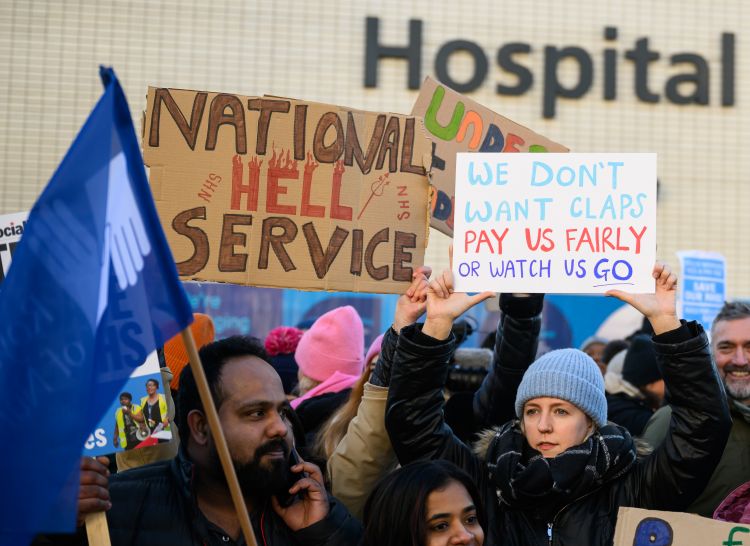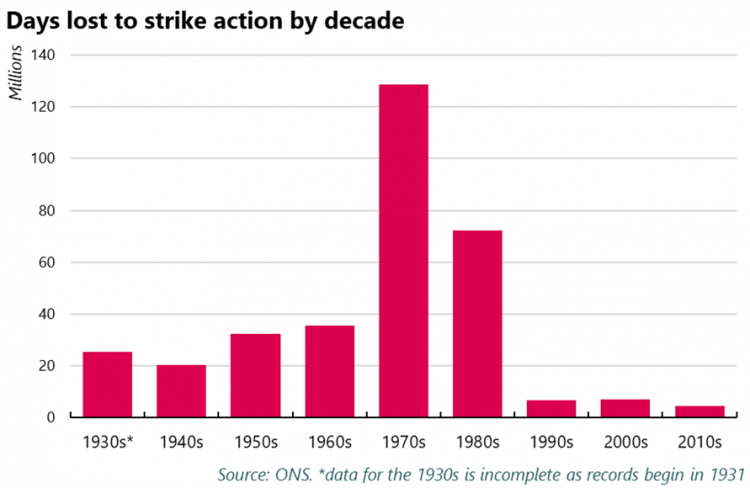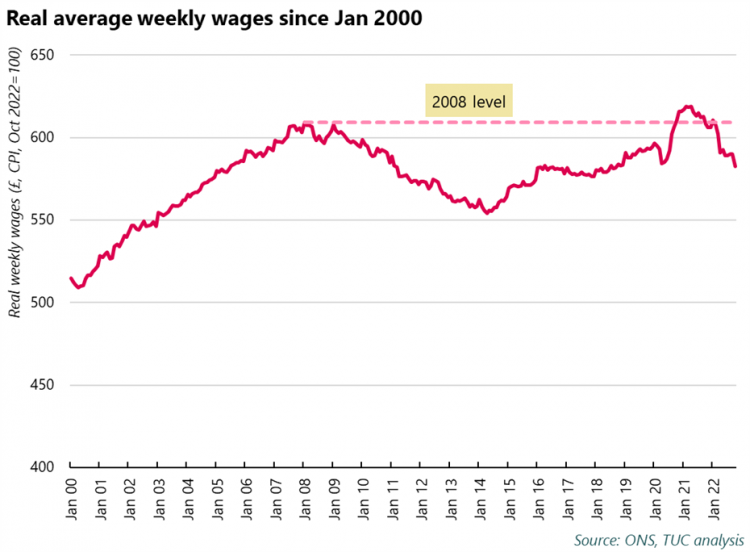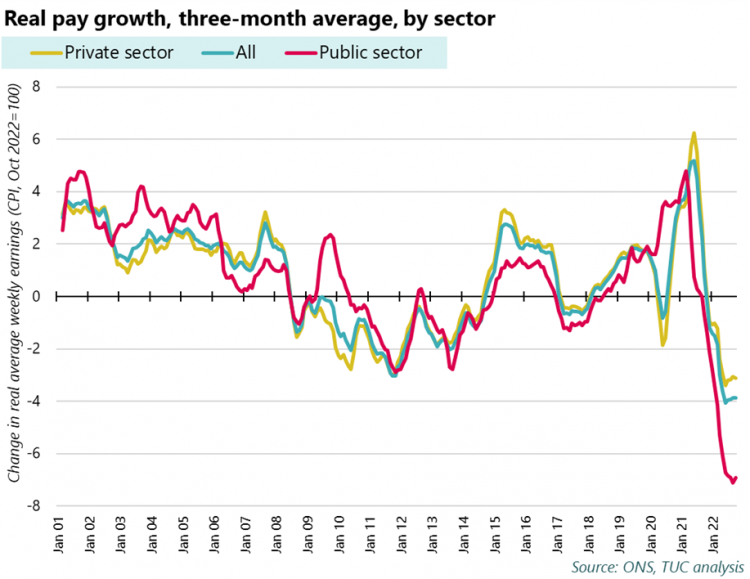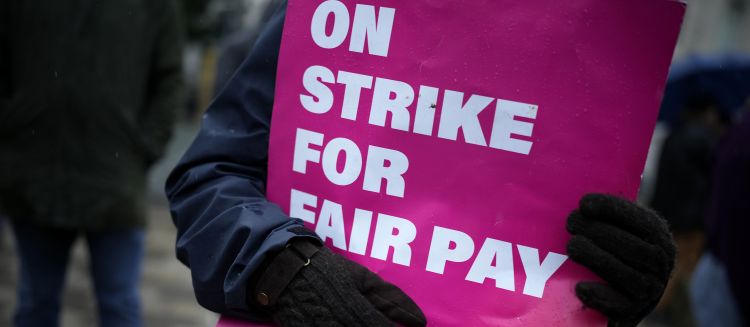Why are workers striking?
These are individual disputes, and it's important to understand the details in different workplaces. But there is a common cause: a pay disaster that means workers are being paid less in real terms now than they were 14 years ago.
First things first – what’s a strike?
Trade unions exist to defend their members’ jobs, pay and conditions. Normally they try to do that through negotiations with employers, through a process called collective bargaining. But when those negotiations break down, workers have the right to collectively withdraw their labour to help bring the employer back to the bargaining table.
In Britain, the right to strike is governed by complex and restrictive industrial action laws. In summary, to count as ‘protected industrial action’, a strike must:
- relate to a work dispute with your own employer
- be supported by a valid secret postal ballot with independent scrutiny, in which at least of half the balloted workers have voted (in other words, “not voting” counts as a vote against the strike)
- be carried out with notice
In addition, since the Tories’ 2016 Trade Union Act strikes involving workers who provide what the government calls an “important public service” can only be lawful if at least 40% of the workers balloted over the action vote in favour of it.
How much has strike activity increased?
The number of strikes has been on the rise in recent months. The latest data shows that the 417,000 days were lost due to strike action in October 2022, the highest it’s been in 11 years. Some are estimating that this December will see over a million days lost to strike action for the first time since 1989.
But it’s important to put the recent rise in strike action into context. While the number of days lost due to strike action is relatively high compared to the past couple of decades, they’d be fairly standard in any decade before the 1990s.
If more than one million working days are lost due to strikes in December, it'll be the first time it's happened since July 1989. But between 1970 and 1989, there were 47 months when this happened. And the 417,000 days lost due to strike action in October 2022 may be the fifth highest on record since 1990, but we regularly saw far higher figures pre-1990.
So what’s behind the rise?
Each individual strike will have different reasons behind it, but there’s some common factors behind the recent rise.
Work has been getting worse for many – lower paid, worse conditions, increasingly insecure. At the same time as workers have seen pay and conditions get worse, businesses have been giving more and more money to shareholders, with dividends paid out to shareholders growing three times faster than wages over the past decade. And the government has been refusing to properly fund pay rises for public sector workers, failing to introduce a proper minimum wage, and attacking trade union rights, and failing to introduce a proper minimum wage. The government’s minimum wage remains below the Real Living Wage set by the Living Wage Foundation, and, even with next year’s rise, will be £4.58 below a £15 per hour minimum wage.
Pay
We’ll start with pay. Average real pay (that’s wages once you take inflation into account) is lower now than it was in 2008. It’s not expected to go back above 2008 levels until 2027. This 19-year pay squeeze is longer than any pay squeeze we have official records for, and likely the longest since Napoleonic times.
If wages had grown in line with pre-2008 trends over the past fourteen years, they’d now be £291 per week higher than they currently are.
Over a decade of stagnant pay has directly contributed to the current crisis, leaving many people unable to cope with a sudden rise in prices. While the cost of living crisis is often presented as a recent problem, it’s been building for years. The situation was already dire before energy bills began to rise. As we went into the pandemic, the number of people in poverty was at a record high, with the majority of those in poverty living in a working household. Household debt was also at a record high, as was food bank use and the number of people seeking debt advice.
The recent rise in prices has made the situation even worse. After years of stagnant pay, workers are now facing double-digit inflation while being offered single-digit pay rises. The latest data shows that, in October, nominal pay rose by 6.4 per cent, while inflation hit 11.1 per cent. Real pay has fallen by £111 per month in the past year alone.
This is particularly bad in the public sector, where pay is rising by just 3.8 per cent, and average real pay has fallen by £185 per month in the past year.
Weak pay growth in the public sector is down to the government refusing to give proper pay rises to workers that kept the country running during the pandemic. Look at health workers, for example. TUC analysis of NHS pay scales shows that:
- Nurses’ real pay fell by £1,800 over the last year
- Paramedics’ real pay fell by £2,400 over the last year
- Midwives’ real pay fell by £2,400 over the last year
This is after a decade of pay suppression by government that has led to nurses earning £5,000 a year less in real terms than they were in 2010. For midwives and paramedics this rises to over £6,000.
Working conditions and job losses
But it’s not just about pay. Many of the current strikes happening aren’t just about getting pay rising, but also protecting jobs, fighting against worsening working conditions, and putting an end to insecure contracts and outsourcing.
The UCU members striking in universities, for example, are fighting not just for better pay, but an end to casualisation and dangerously high workloads. Similarly, striking postal workers are fighting against the unagreed imposition of new working conditions, and part of the rail workers dispute is about job losses and worsening conditions.
Fighting for pay itself is often a fight to improve working conditions. Better pay helps with recruitment and retention of staff.
It’s a political choice
The government spent months clapping for key workers, but now refuses to give them a fair pay rise. This is a political choice. The government could avoid, for example, rail workers, nurses, teachers, paramedics striking by getting around the negotiating table and offering a decent, fair pay rise.
Instead, it continues to offer real pay cuts to public sector workers, often hiding behind pay review bodies while it does. And when it comes to rail workers, the government is actively blocking deals being made. This is all part of wider cuts to public services that have left them understaffed and underfunded.
The government doesn’t agree pay deals in the private sector, but it can set a positive example to employers by offering decent pay rises. It also has the power to deliver increases to the minimum wage that get it to £15 an hour. But instead, the government has repeatedly attacked trade union rights, making it harder to strike and therefore harder to negotiate for better pay.
Workers are winning
There’s another reason behind the rise in the number of people gaining confidence to take action: workers are winning. People are winning better pay deals and working conditions by joining together and standing up for themselves. Striking workers have won themselves double-digit pay rises across a range of different jobs, from bus drivers to BT engineers, as well as better conditions and an end to outsourcing.
If you aren’t in a union yet, there’s never been a better time to join – talk to your mates and talk to a union. And to learn more on how the TUC is supporting union disputes, see our solidarity hub here.
Stay Updated
Want to hear about our latest news and blogs?
Sign up now to get it straight to your inbox

